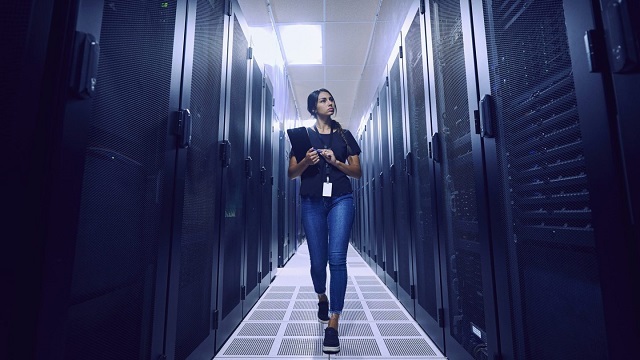Alberta
AI-driven data centre energy boom ‘open for business’ in Alberta

From the Canadian Energy Centre
By Deborah Jaremko and Will Gibson“These facilities need 24/7, super-reliable power, and there’s only one power generation fuel that has any hope of keeping up with the demand surge: natural gas”
Data centres – the industrial-scale technology complexes powering the world’s growing boom in artificial intelligence – require reliable, continuous energy. And a lot of it.
“Artificial Intelligence is the next big thing in energy, dominating discussions at all levels in companies, banks, investment funds and governments,” says Simon Flowers, chief analyst with energy consultancy Wood Mackenzie.
The International Energy Agency (IEA) projects that the power required globally by data centres could double in the next 18 months. It’s not surprising given a search query using AI consumes up to 10 times the energy as a regular search engine.
The IEA estimates more than 8,000 data centres now operate around the world, with about one-third located in the United States. About 300 centres operate in Canada.
It’s a growing opportunity in Alberta, where unlike anywhere else in the country, data centre operators can move more swiftly by “bringing their own power.”
In Alberta’s deregulated electricity market, large energy consumers like data centres can build the power supply they need by entering project agreements directly with electricity producers instead of relying solely on the power of the existing grid.
Between 2018 and 2023, data centres in Alberta generated approximately $1.3 billion in revenue, growing on average by about eight percent per year, lawyers with Calgary-based McMillan LLP wrote in July.
“Alberta has a long history of building complex, multi-billion-dollar infrastructure projects with success and AI data centres could be the next area of focus for this core competency,” McMillan’s Business Law Bulletin reported.
In recent years, companies such as Amazon and RBC have negotiated power purchase agreements for renewable energy to power local operations and data centres, while supporting the construction of some of the country’s largest renewable energy projects, McMillan noted.
While the majority of established data centres generally have clustered near telecommunications infrastructure, the next wave of projects is increasingly seeking sites with electricity infrastructure and availability of reliable power to keep their servers running.
The intermittent nature of wind and solar is challenging for growth in these projects, Rusty Braziel, executive chairman of Houston, Texas-based consultancy RBN Energy wrote in July
“These facilities need 24/7, super-reliable power, and there’s only one power generation fuel that has any hope of keeping up with the demand surge: natural gas,” Braziel said.
TC Energy chief operating officer Stan Chapman sees an opportunity for his company’s natural gas delivery in Canada and the United States.
“In Canada, there’s around 300 data centre operations today. We could see that load increasing by one to two gigawatts before the end of the decade,” Chapman said in a conference call with analysts on August 1.
“Never have I seen such strong prospects for North American natural gas demand growth,” CEO François Poirier added.
Alberta is Canada’s largest natural gas producer, and natural gas is the base of the province’s power grid, supplying about 60 percent of energy needs, followed by wind and solar at 27 percent.
“Given the heavy power requirements for AI data centres, developers will likely need to bring their own power to the table and some creative solutions will need to be considered in securing sufficient and reliable energy to fuel these projects,” McMillan’s law bulletin reported.
The Alberta Electric System Operator (AESO), which operates the province’s power grid, is working with at least six proposed data centre proposals, according to the latest public data.
“The companies that build and operate these centres have a long list of requirements, including reliable and affordable power, access to skilled labour and internet connectivity,” said Ryan Scholefield, the AESO’s manager of load forecasting and market analytics.
“The AESO is open for business and will work with any project that expresses an interest in coming to Alberta.”
Alberta
They never wanted a pipeline! – Deputy Conservative Leader Melissa Lantsman

From Melissa Lantsman
Turns out the anti-development wing of the Liberal Party never stopped running the show.
Today, we’ll see if the Liberals vote for the pipeline they just finished bragging about.
Spoiler: they won’t. Because with the Liberals, the announcements are real, but the results never are.
Alberta
Premier Smith: Canadians support agreement between Alberta and Ottawa and the major economic opportunities it could unlock for the benefit of all

From Energy Now
By Premier Danielle Smith
Get the Latest Canadian Focused Energy News Delivered to You! It’s FREE: Quick Sign-Up Here
If Canada wants to lead global energy security efforts, build out sovereign AI infrastructure, increase funding to social programs and national defence and expand trade to new markets, we must unleash the full potential of our vast natural resources and embrace our role as a global energy superpower.
The Alberta-Ottawa Energy agreement is the first step in accomplishing all of these critical objectives.
Recent polling shows that a majority of Canadians are supportive of this agreement and the major economic opportunities it could unlock for the benefit of all Canadians.
As a nation we must embrace two important realities: First, global demand for oil is increasing and second, Canada needs to generate more revenue to address its fiscal challenges.
Nations around the world — including Korea, Japan, India, Taiwan and China in Asia as well as various European nations — continue to ask for Canadian energy. We are perfectly positioned to meet those needs and lead global energy security efforts.
Our heavy oil is not only abundant, it’s responsibly developed, geopolitically stable and backed by decades of proven supply.
If we want to pay down our debt, increase funding to social programs and meet our NATO defence spending commitments, then we need to generate more revenue. And the best way to do so is to leverage our vast natural resources.
At today’s prices, Alberta’s proven oil and gas reserves represent trillions in value.
It’s not just a number; it’s a generational opportunity for Alberta and Canada to secure prosperity and invest in the future of our communities. But to unlock the full potential of this resource, we need the infrastructure to match our ambition.
There is one nation-building project that stands above all others in its ability to deliver economic benefits to Canada — a new bitumen pipeline to Asian markets.
The energy agreement signed on Nov. 27 includes a clear path to the construction of a one-million-plus barrel-per-day bitumen pipeline, with Indigenous co-ownership, that can ensure our province and country are no longer dependent on just one customer to buy our most valuable resource.
Indigenous co-ownership also provide millions in revenue to communities along the route of the project to the northwest coast, contributing toward long-lasting prosperity for their people.
The agreement also recognizes that we can increase oil and gas production while reducing our emissions.
The removal of the oil and gas emissions cap will allow our energy producers to grow and thrive again and the suspension of the federal net-zero power regulations in Alberta will open to doors to major AI data-centre investment.
It also means that Alberta will be a world leader in the development and implementation of emissions-reduction infrastructure — particularly in carbon capture utilization and storage.
The agreement will see Alberta work together with our federal partners and the Pathways companies to commence and complete the world’s largest carbon capture, utilization and storage infrastructure project.
This would make Alberta heavy oil the lowest intensity barrel on the market and displace millions of barrels of heavier-emitting fuels around the globe.
We’re sending a clear message to investors across the world: Alberta and Canada are leaders, not just in oil and gas, but in the innovation and technologies that are cutting per barrel emissions even as we ramp up production.
Where we are going — and where we intend to go with more frequency — is east, west, north and south, across oceans and around the globe. We have the energy other countries need, and will continue to need, for decades to come.
However, this agreement is just the first step in this journey. There is much hard work ahead of us. Trust must be built and earned in this partnership as we move through the next steps of this process.
But it’s very encouraging that Prime Minister Mark Carney has made it clear he is willing to work with Alberta’s government to accomplish our shared goal of making Canada an energy superpower.
That is something we have not seen from a Canadian prime minister in more than a decade.
Together, in good faith, Alberta and Ottawa have taken the first step towards making Canada a global energy superpower for benefit of all Canadians.
Danielle Smith is the Premier of Alberta
-

 COVID-192 days ago
COVID-192 days agoUniversity of Colorado will pay $10 million to staff, students for trying to force them to take COVID shots
-

 Bruce Dowbiggin2 days ago
Bruce Dowbiggin2 days agoIntegration Or Indignation: Whose Strategy Worked Best Against Trump?
-

 Focal Points2 days ago
Focal Points2 days agoCommon Vaccines Linked to 38-50% Increased Risk of Dementia and Alzheimer’s
-

 espionage2 days ago
espionage2 days agoWestern Campuses Help Build China’s Digital Dragnet With U.S. Tax Funds, Study Warns
-

 Opinion2 days ago
Opinion2 days agoThe day the ‘King of rock ‘n’ roll saved the Arizona memorial
-

 Bruce Dowbiggin2 days ago
Bruce Dowbiggin2 days agoWayne Gretzky’s Terrible, Awful Week.. And Soccer/ Football.
-

 Agriculture2 days ago
Agriculture2 days agoCanada’s air quality among the best in the world
-

 Health1 day ago
Health1 day agoCDC Vaccine Panel Votes to End Universal Hep B Vaccine for Newborns






